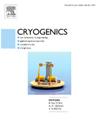A novel numerical simulation approach for cryogenic CO2 frosting in binary mixture gas by integrating desublimation and gas-solid phase equilibrium models
IF 1.8
3区 工程技术
Q3 PHYSICS, APPLIED
引用次数: 0
Abstract
Cryogenic CO2 separation from natural gas is a promising technology due to its environmental benefits and smaller spatial requirement. Nonetheless, the dynamics of CO2 desublimation and subsequent frost layer formation under cryogenic conditions for natural gas pre-treatment remain largely unexplored. Addressing this gap, this paper presents a novel numerical simulation approach by integrating desublimation phase change model and vapor-solid phase equilibrium model to investigate CO2 frost layer formation on the cold wall, revealing that both the cold wall temperature and the initial CO2 concentration significantly influence the thickness of the CO2 frost layer. Moreover, the study finds that the density of frost layer intensifies over time, with the highest density observed near the cold surface. Furthermore, increasing the cold wall temperature and the flow rate not only increases the average density of the CO2 frost layer but also affects the outlet CO2 concentration. To adhere to specific outlet CO2 concentration targets and desublimation duration, it is critical to adjust the cold wall temperature and the inlet flow velocity dynamically. Therefore, cryogenic CO2 removal methods, by reducing the spatial requirements of CO2 pre-treatment units, offer a practical and efficient solution for small-scale natural gas liquefaction plants. This approach not only facilitates operational efficiency but also contributes to the broader effort of mitigating greenhouse gas emissions, aligning with environmental sustainability objectives.
通过整合解升华模型和气固相平衡模型实现二元混合气体中二氧化碳低温结霜的新型数值模拟方法
从天然气中低温分离二氧化碳因其环保优势和较小的空间需求而成为一项前景广阔的技术。然而,在天然气预处理的低温条件下,二氧化碳脱华和随后霜层形成的动态过程在很大程度上仍未得到研究。针对这一空白,本文提出了一种新颖的数值模拟方法,通过整合解升华相变模型和汽固相平衡模型来研究冷壁上二氧化碳霜层的形成,发现冷壁温度和初始二氧化碳浓度都会显著影响二氧化碳霜层的厚度。此外,研究还发现,霜层的密度会随着时间的推移而增大,在冷表面附近的霜层密度最大。此外,提高冷壁温度和流速不仅会增加二氧化碳霜层的平均密度,还会影响出口二氧化碳浓度。为了达到特定的出口二氧化碳浓度目标和脱附持续时间,动态调整冷壁温度和入口流速至关重要。因此,低温二氧化碳去除方法通过降低二氧化碳预处理装置的空间要求,为小型天然气液化工厂提供了一种实用高效的解决方案。这种方法不仅提高了运行效率,还有助于减少温室气体排放,实现环境可持续发展目标。
本文章由计算机程序翻译,如有差异,请以英文原文为准。
求助全文
约1分钟内获得全文
求助全文
来源期刊

Cryogenics
物理-热力学
CiteScore
3.80
自引率
9.50%
发文量
0
审稿时长
2.1 months
期刊介绍:
Cryogenics is the world''s leading journal focusing on all aspects of cryoengineering and cryogenics. Papers published in Cryogenics cover a wide variety of subjects in low temperature engineering and research. Among the areas covered are:
- Applications of superconductivity: magnets, electronics, devices
- Superconductors and their properties
- Properties of materials: metals, alloys, composites, polymers, insulations
- New applications of cryogenic technology to processes, devices, machinery
- Refrigeration and liquefaction technology
- Thermodynamics
- Fluid properties and fluid mechanics
- Heat transfer
- Thermometry and measurement science
- Cryogenics in medicine
- Cryoelectronics
 求助内容:
求助内容: 应助结果提醒方式:
应助结果提醒方式:


